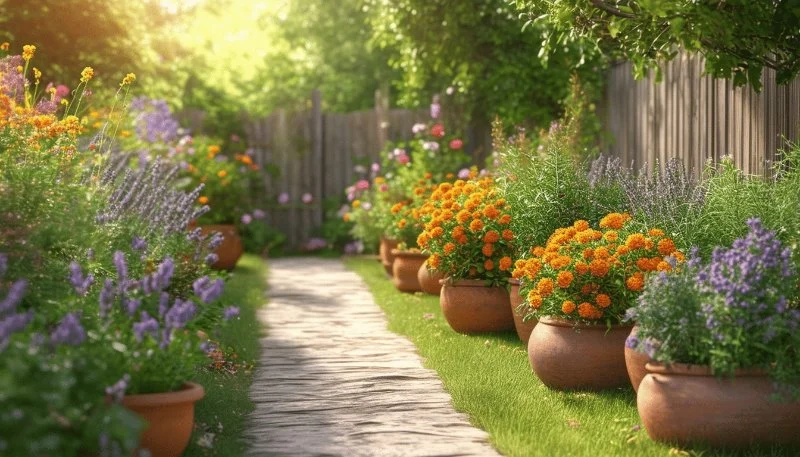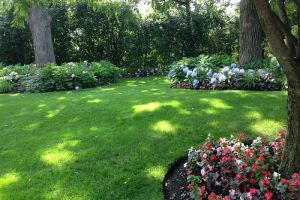
- 1. Why Movement in Gardens Matters
- 2. Choosing Plants That Sway Gracefully
- 3. Designing With Movement in Mind
- 4. Maintenance and Care of Flowing Plants
1. Why Movement in Gardens Matters
When designing a garden, most people focus on color, texture, and shape. However, one often-overlooked element that can transform your garden is movement. Adding plants that sway gracefully can bring a dynamic, ever-changing element to your garden, providing both visual and sensory appeal. The gentle rustling of leaves or the movement of tall grasses in the wind can create a peaceful, calming atmosphere in your outdoor space.
Movement not only adds aesthetic value but also enhances the overall feel of a garden. It can soften harsh lines, draw attention to specific areas, and even create a sense of depth and dimension in small spaces. Whether it's the soft rustle of ornamental grasses or the swaying of tall, flower-filled stems, plants that move help bring your garden to life.

JMR Landscaping, LLC
LibertyvilleLake CountyIllinois
1930 Innovation Wy Suite #210, Libertyville, IL 60048, USA
2. Choosing Plants That Sway Gracefully
The key to adding movement to your garden lies in selecting the right plants. Some plants naturally sway in the breeze, while others require a little more attention to placement and design. Here are some types of plants that are known for their graceful movement:
- Ornamental Grasses: Grasses like Pennisetum, Miscanthus, and Panicum are perfect for creating swaying movement. Their long, slender blades gently bend in the wind, adding soft texture and motion.
- Flowers with Tall Stems: Plants like Lupines, Delphiniums, and Rudbeckia add verticality and movement, especially when planted in clusters. Their stems sway and bend with the breeze, creating a graceful effect.
- Climbing Vines: Vines such as Wisteria or Clematis bring a flowing, cascading effect to your garden. When planted along fences, pergolas, or trellises, they create movement that complements the surrounding landscape.
- Soft Foliage Plants: Plants with delicate foliage, such as Japanese Maple or Hostas, can add a soft sway in light winds, contributing subtle movement in shaded areas.
It's important to select plants that suit your garden's environment. Pay attention to factors such as sunlight, soil type, and climate when choosing plants that will thrive and create movement in your space. Combining different plant heights, textures, and forms will create a more dynamic and varied display.
3. Designing With Movement in Mind
When incorporating movement into your garden design, consider the layout and how plants will interact with each other. Placement is crucial to ensure that your chosen plants flow with the natural surroundings. Here's how to design your garden to maximize the movement of plants:
- Use Layering Techniques: Layering plants with varying heights and textures will create an undulating effect, making your garden feel full of life. Taller plants in the background, with shorter ones in the foreground, create a dynamic contrast that enhances the visual flow of your garden.
- Create Focal Points: Position plants with striking movement at key focal points in your garden, such as near pathways, seating areas, or entrances. This draws the eye to these areas and creates an inviting atmosphere.
- Consider Wind Direction: Think about the prevailing winds in your area when choosing where to plant. Arrange plants that sway gracefully in areas where they will catch the wind, such as near open spaces or along edges.
- Combine with Hardscaping Elements: Incorporate movement alongside hardscaping elements like water features, walkways, or fences. Water features, such as fountains or ponds, also provide movement, complementing the sway of plants and enhancing the sensory experience of your garden.
By carefully selecting plant types and planning their placement, you can design a garden that flows with beauty and movement, creating a more immersive and enjoyable space for both relaxation and exploration.
4. Maintenance and Care of Flowing Plants
Maintaining plants that sway gracefully is relatively simple, but they do require some care to ensure they continue to thrive. Here are a few tips for keeping your dynamic garden plants healthy and looking their best:
- Prune Regularly: Regular pruning helps remove dead or damaged parts of plants and encourages new growth. For plants that sway, it’s important to remove any brown or broken stems to maintain their graceful appearance.
- Provide Proper Watering: While plants with graceful movement often thrive in various conditions, they still require proper watering. Ensure they get enough water during dry spells, especially grasses and tall flowers that may have deep roots.
- Mulch to Retain Moisture: Mulch around the base of plants to retain moisture, suppress weeds, and protect roots from extreme temperatures. Organic mulches, like bark or straw, also break down over time, adding nutrients to the soil.
- Feed Occasionally: While many plants are low-maintenance, periodic feeding can enhance their growth. Use a balanced, slow-release fertilizer during the growing season to encourage healthy, vibrant plants.
By following these simple care guidelines, your plants will continue to add movement and grace to your garden for years to come.
Designing with plants that sway gracefully can turn any garden into a dynamic, beautiful space. Whether you want to create a tranquil retreat or a lively outdoor area, adding plants with movement will help bring your vision to life. Explore more landscaping tips and products at Beautiful Landscapes to elevate your garden design today.








 Infinity Lawn & Landscaping4.0 (52 reviews)
Infinity Lawn & Landscaping4.0 (52 reviews) QualityWorks Trademark LLC4.0 (30 reviews)
QualityWorks Trademark LLC4.0 (30 reviews) Eubanks Environmental5.0 (10 reviews)
Eubanks Environmental5.0 (10 reviews) BrightView Landscape3.0 (16 reviews)
BrightView Landscape3.0 (16 reviews) Statements In Stone Pool and Patio4.0 (47 reviews)
Statements In Stone Pool and Patio4.0 (47 reviews) Schmitt's Landscape Tree service North Aurora4.0 (4 reviews)
Schmitt's Landscape Tree service North Aurora4.0 (4 reviews) How to Landscape for Seasonal Wildlife Attraction in Your Garden
How to Landscape for Seasonal Wildlife Attraction in Your Garden How to Build a Wildlife Habitat Garden That Supports Biodiversity
How to Build a Wildlife Habitat Garden That Supports Biodiversity How to Use Garden Art to Add Personality to Your Outdoor Space
How to Use Garden Art to Add Personality to Your Outdoor Space How to Plan Outdoor Fire & Water Features Harmoniously for Your Garden
How to Plan Outdoor Fire & Water Features Harmoniously for Your Garden How to Revive a Neglected Lawn Step by Step
How to Revive a Neglected Lawn Step by Step How to Choose Native Shrubs That Thrive Without Fertilizer
How to Choose Native Shrubs That Thrive Without Fertilizer